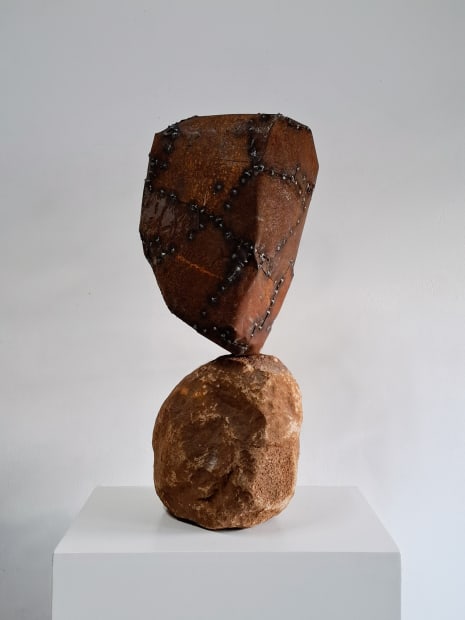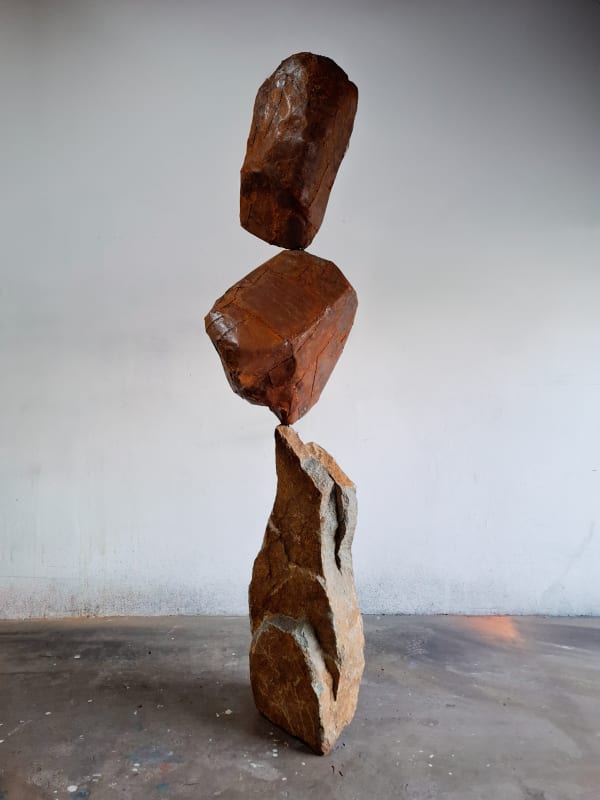-
Q: How would you say that your work offers insight into the human impact on the environment and the current climate crisis?A: While not overtly political, my sculptures engage with environmental themes through material sensitivity and metaphor. The rusting of steel through exposure to rain is both a natural and symbolic process — nature reclaiming and transforming the human-made. This interplay between human intervention and natural force subtly gestures toward our relationship with the environment. By working with materials that change over time, I hope to draw attention to the slow, often unnoticed processes of degradation, transformation, and renewal—echoing the broader ecological cycles we are a part of, and sometimes disrupt.
-

-
Q: How do you arrive at the ideas that inspire the shape and medium of the sculptures you create?A: My process almost always begins with the rocks. I spend time observing their forms, textures, and natural irregularities—how they lean, how they rest. Each rock suggests a possibility, a kind of quiet logic that I try to follow. From there, I imagine how shaped steel might echo the form, creating a dialogue between the two materials. I try to find a balanced harmony—physically, visually, and conceptually. I’m drawn to the tension between weight and weightlessness, between what appears solid and what seems to defy gravity. The ideas don’t come all at once; they unfold through a process of listening, arranging, and responding to the material. The forms evolve as I search for moments where structure and meaning align — where the piece feels both grounded and suspended.
-
-
Q: You are not just a sculpture artist, but rather you also include painting in your oeuvre, notably landscapes and wildlife are often depicted in black and white. Which do you prefer most, painting or sculpting?A: It’s difficult to choose between them, as both sculpture and drawing offer distinct but interconnected ways of thinking and making. Sculpture allows me to engage physically with space and weight—there’s something deeply grounding in the act of shaping metal against stone, in balancing the seen with the felt. It’s tactile, immediate, and architectural.
My charcoal drawings, on the other hand, lean into gesture and atmosphere. Working with fibre cement as a surface, and using water as an active force in the drawing process, I explore ideas of erasure, renewal, and spiritual resonance. It’s a quieter process, but no less physical. Pouring water over a completed drawing invites a kind of surrender—a willingness to let the work transform, to embrace imperfection and passage.
So rather than preferring one over the other, I see both as extensions of the same inquiry. They each explore the tension between permanence and impermanence, materiality and immateriality, but through different sensory languages.
-
-

-
Q: Can you describe your artistic process, both for your sculptures and your paintings?
A: For my sculptures, the process begins with rocks—found forms that already carry a sense of presence. I study them, arrange them, and consider how they might interact to form a balanced, almost meditative composition. Steel sheets are then hammered and shaped against these rocks, echoing their form without fully imitating it. Once welded, the sculptures are left to the elements, particularly rain, which oxidizes the surface over time. This slow collaboration with nature becomes part of the piece’s voice—adding texture, colour, and a sense of weathered history.With my charcoal drawings, the process is similarly layered but more ephemeral. I draw detailed landscapes—often featuring sheep—onto fibre cement using charcoal, and then deliberately disrupt the image by pouring water over it. This act, repeated multiple times, washes away parts of the drawing while leaving behind stains, drips, and smears. The result is an image in flux—a surface marked by intention and surrender, by what is made and what is undone. It’s a ritual that speaks to transformation, memory, and spiritual presence.Both processes involve tension and release, precision and erosion. Whether working in steel or charcoal, I’m interested in how material carries meaning—and how gesture, time, and process can turn an object or image into something contemplative and alive.



